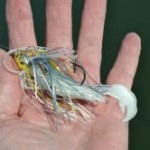Swimming the Jig for Bass In Late Spring
A great postspawn tactic.
By Frank Sargeant
from The Fishing Wire
Swimming a jig is basically a postspawn tactic; the fish that have spawned in the pads, primrose vines and other emergent weeds remain in the shallows for days or sometimes weeks after leaving the beds, and they’re typically very hungry. The places they prowl may be anywhere from a foot to 4 feet deep, typically in the backs of the feeder creeks that make up the bays around the larger lakes across much of the southeast and west into Texas.
The jigs that work best are not the heavy, fat models that work so well on the ledges. Swim jigs are flat-bottomed to help them scoot across the weeds, and are typically lighter in weight than those used in deep water, from 3/16 to ½ ounce, with large hooks designed to hold large soft plastic crawfish or swimmer tails. A nylon weedguard is also standard, helping to keep the single-hook lures from catching the cover.
These lures are cast into cover near spawning areas-sometimes the shadows of the beds can still be seen in the cover. However, the fish may be some distance from the nests-they no longer guard them after the fry swim off on their own, but they do hang in the area to feed for a time.
The trick in working a swim jig is to put the reel in gear instantly at the end of the cast, keep the rod high, and start the lure moving, slowly but steadily, just fast enough to activate the soft plastic swimmer legs or tails. Most anglers use either heavy mono, 25 pound test, or braid of 30 pound test or heavier, to allow pulling the lure free when it snags-and also to give them a chance to derrick large bass out of the thick stuff.
The strikes tend to be sudden and explosive-it’s just short of the blow-ups inspired in fall by crawling a frog over the moss beds. The nice advantage of swimming the open hook jigs is that the fish more often than not actually get hooked, not the case with the weedless but sometimes also fishless frogs.
Once a fish strikes, the tactic that works best is to set the hook hard, then crank as fast as possible with the rod high-ideally, you pop the fish up on top of the weeds and scoot him across them to open water. Of course, this plan is not always effective-they often bog down, and then the only way to get them out is to ease in on the troller, follow the line down and get a liplock on them.
It’s also common for fish to blow up on the lures and miss them completely. When this happens, a second cast back to the same spot immediately often gets a second strike, but if not it can be useful to keep a Texas-rigged worm handy on the front deck. Cast the worm to the spot of the blow-up, bounce it up and down in the cover a few times, and you’ll often coerce the fish into taking.
All colors of swim jigs work, but the ones that are easiest to see are the brighter colors-white, pearl or chartreuse are easy for you and the bass to spot.
Fishing the swimjig is a short window in the fishing spectrum, but it’s one of the more interesting and productive tactics for big fish when the bite is on-give it a try this spring.
